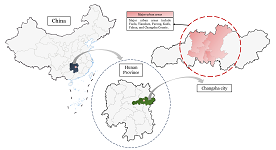
Asia Pacific Academy of Science Pte. Ltd. (APACSCI) specializes in international journal publishing. APACSCI adopts the open access publishing model and provides an important communication bridge for academic groups whose interest fields include engineering, technology, medicine, computer, mathematics, agriculture and forestry, and environment.

As China's pillar industry, the property market has suffered a considerable impact in recent years, with a decline in turnover and many developers at risk of bankruptcy. As one of the most concerned factors for stakeholders, housing prices need to be predicted more objectively and accurately to minimize decision-making errors by developers and consumers. Many prediction models in recent years have been unfriendly to consumers due to technical difficulties, high data demand, and varying factors affecting house prices in different regions. A uniform model across the country cannot capture local differences accurately, so this study compares and analyses the fitting effects of multiple machine learning models using February 2024 new building data in Changsha as an example, aiming to provide consumers with a simple and practical reference for prediction methods. The modeling exploration applies several regression techniques based on machine learning algorithms, such as Stepwise regression, Robust regression, Lasso regression, Ridge regression, Ordinary Least Squares (OLS) regression, Extreme Gradient Boosted regression (XGBoost), and Random Forest (RF) regression. These algorithms are used to construct forecasting models, and the best-performing model is selected by conducting a comparative analysis of the forecasting errors obtained between these models. The research found that machine learning is a practical approach to property price prediction, with least squares regression and Lasso regression providing relatively more convincing results.
Research on bio-cultural diversity in ethnic areas–based on the investigation of bio-culture in Jinxiu, Guangxi
Vol 1, Issue 1, 2020
Download PDF
Abstract
The biological culture as a new cultural concept and form of expression, attaches great importance to the internal relation between culture and biological, enrich and perfect the traditional ecological culture elements such as concept, value orientation, a nd inspire modest grab in natural resources, respect nature, respect nature of cultural behavior, real-ize the harmonious development of man and nature. As stewards of local natural ecosystems, ethnic minorities main-tain biological diversity through their traditional cultures, such as living customs, religious beliefs and customary laws. As the material basis for its survival, biodiversity also enriches and develops cultural diversity. Biodiversity and cul-tural diversity interact and develop synergistically. Biological research ethnic areas - the formation and development of cultural diversity, biological and cultural interaction relations, the external factors of biological, cultural diversity and its future development trend of change, the influence of the understanding of the biological culture connotation and biological - synergy to protect cultural diversity has important theoretical and practical significance
Keywords
References
- Mao S, Shen Y, Deng H. Research progress on bio-logical-cultural diversity. Chinese Journal of Ecology, 2017(24): 8179–8186.
- Xue D. Traditional culture and biodiversity protec-tion in ethnic areas. Beijing: China Environment Press, 2009: 10–15.
- Jiang Z, Ma P, Han X. Conservation Biology. Hangzhou: Zhejiang Science and Technology Press, 1999: 35–37.
- Wilson EO. The Diversity of Life. Cambridge: Harvard University, 1992.
- Sun R. Biodiversity loss and protection. Nature Exploration, 2001(9): 44–45.
- Mark P. On the concept of biodiversity. Biodiversity, 1993(1): 20–22.
- Wang X. Diversity of Fujian culture and analysis of its geographical environment. Journal of Fujian Normal University, 2002(1): 96–101.
- Julian S. Cultural Change Theory. Tan Weihua, Luo Kanglong, translated. Guiyang: Guizhou People’s Publishing House, 2013: 56–58.
- Zhuang X, Sun Z. The theoretical framework of cultural anthropology. Hangzhou: Zhejiang Peo-ple’s Publishing House, 1988: 171–172.
- Xia J. Cultural Anthropology Theory School. Bei-jing: Renmin University of China Press, 2003: 9–12.
- Pei S. National culture and biodiversity conserva-tion. Proceedings of the Chinese Academy of Sci-ences, 2011(2): 190–196.
- Xu Z. Biodiversity Conservation and Cultural Di-versity Conservation. Biodiversity, 2015(1): 126–130.
- Yang T, Yang C. Dong culture and biodiversity maintenance. Journal of Huaihua University, 2008(6): 1–3.
- Xue D, Guo L. On the concept and protection of traditional knowledge. Biodiversity, 2009 (2): 135–142.
- Xue D. The Categories and Benefit –sharing of Traditional Knowledge Associated with Biodiver-sity. Journal of Resources and Ecology, 2011(1): 289–299.
- Yang L, Pei S. Naxi Dongba culture and biodiversity conservation. Forestry Survey Planning, 2008(2): 76–79.
- Wang Y, Xue D. On the role of traditional knowledge of Dong nationality in biodiversity conservation. Guizhou Social Sciences, 2015(2): 95–99.
- Cai J, Zhuo M, Xue D. Influence of Tibetan tradi-tional culture in Qinghai on resource utilization of highland barley varieties. Guizhou Social Sciences, 2016(2): 135–139.
- Qin B. Tourism resource development and ecolog-ical environment protection of Dayao Mountain Nature Reserve in Guangxi. Environmental Science Guide, 2007(3): 14–17.
- Yan S. Research on the development of Guizhou’s cultural industry in the new round of western de-velopment. Economic Perspective, 2011(27): 11–12.
Supporting Agencies
Copyright (c) 2020 Baoping Li, Dayuan Xue

This work is licensed under a Creative Commons Attribution 4.0 International License.

This site is licensed under a Creative Commons Attribution 4.0 International License (CC BY 4.0).

Prof. Mehmet Cetin
Kastamonu University,
Turkey
Polish Scientific Bibliography

